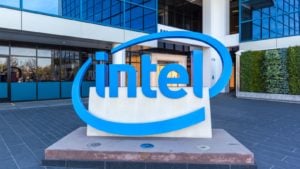[Editor’s note: “7 5G Stocks to Buy Now for the Future” was previously published in August 2019. It has since been updated to include the most relevant information available.]
Since I last wrote about the four best 5G stocks to buy as the trend heated up, the sector has touched new highs. The companies benefited from telecom companies rolling out 5G wireless. That trend is not only heating up, but is accelerating. AT&T (NYSE:T) will offer a fixed-wireless-access solution later this year, letting customers get 5G internet at home. Beating AT&T in the 5G race is Verizon (NYSE:VZ), which officially became the first major U.S. carrier to offer 5G cell service.
Verizon’s victory puts pressure on telecom firms to accelerate their investments in the 5G buildout — or risk falling behind.
Here are seven 5G stocks that should rally in the future as the rest of the sector keeps heating up.
5G Stock to Buy: Ciena Corporation (CIEN)

Ciena Corporation (NYSE:CIEN) stock rebounded from near-$33 lows in May after reporting second-quarter results June 6. The company reported revenue growing by 18.5% to $865 million. CIEN stock’s adjusted earnings per share was 48 cents. Although the company faced tougher year-over-year comparisons, investors bid the stock to yearly highs above $46. In the last few quarters, the company reported a growth rate a few points above the long-term average of 6%-8%. Beyond this year, growth will revert to that 6%-8% range. And EPS growth of 20% a year is sustainable.
Ciena acquired TeraXion for $32 million in 2016, gaining control of its high-speed photonics components, which have enabled Ciena to unroll optical chipsets. This move also gave CIEN the execution capability around TeraXion’s electro-optics portion of the drivetrain as well as the company’s silicon photonics.
The rollout of 5G had a positive impact on the CIEN stock’s most-recent quarter. And Ciena is highly engaged with its customers, especially at the optical project level. With that level of involvement with the largest tier one companies in North America, expect revenue to grow extremely well for the foreseeable future.
Assuming a reasonable five-year compound annual growth rate of 7.1%, CIEN stock has an upside of over 10%.
Cisco Systems (CSCO)

Cisco Systems (NASDAQ:CSCO) stock’s near-term growth will come from being the world’s largest secure domain name system platform, though the data center is another source of core growth. Cisco has around 35 data centers that are growing monthly, as the company expands its cloud. It has 100 million daily users on its platform, yet the company wants to be a bigger player in 5G in the future.
On July 9, Cisco announced that it would buy optical component maker Acacia Communications (NASDAQ:ACIA) for $2.84 billion. In doing so, the telecom equipment supplier will widen its addressable market in the 5G space. And because service providers will put upgrading to 5G on their roadmap, CSCO will have to upgrade its optical components, too. As global internet traffic triples into 2022, Cisco will have a way to sell the hardware customers need to support all that data movement.
Acquiring Acacia gives Cisco the needed expertise in metro, long-haul and undersea data movement. Previously, the company’s optical portfolio covered only short-range data center connections.
CSCO’s integration of Acacia strengthens its positioning for 5G in the future. Acacia already makes many of the optical interconnect modules in Cisco’s equipment. But in the future, the demand for high-speed interconnect will increase rapidly.
Nokia (NOK)

Nokia (NYSE:NOK) reported fiscal second-quarter results that beat consensus estimates. The company has benefited from new 5G deal wins. Helped by improving product competitiveness, the company has an impressive 50 commercial 5G deals.
Nokia is well-positioned to be a 5G player in the future. As Nokia sells 5G radio to customers, it is also selling other Nokia products. Not only that, but NOK is building its 5G business by converting all of its 4G LTE customers — it has over 300 commercial 4G customers who need help transitioning to 5G over the next 10-20 years.
At a forward price-to-earnings ratio of 13, Nokia is not valued as a strong 5G player for the future. Markets are making a mistake ignoring this company’s strong prospects.
As many countries move quickly to deploy 5G, management may raise its guidance. Now, operators expect it will take four or five years after the initial rollout to get 5G deployed to 75% of their customers. That suggests Nokia’s 5G growth acceleration is still in its early stages.
NXP Semiconductors (NXPI)

NXP Semiconductors (NASDAQ:NXPI) has pivoted its business towards the automotive and 5G market over the last few years. Strong 5G deployment in the last few quarters assures the company’s positioning in the space. Its second quarter, posted July 30, met consensus estimates. This is due partly to the benefit of a large mobile customer, but the higher revenue from the customer also led to lower deployment in the current Q3. To adjust for the uncertainties, NXPI lowered its Q3 revenue guidance to $2.21 billion-$2.27 billion. This is below the $2.35 billion estimated revenue.
NXPI stock fell to as low as $96.11 by Aug. 5, only to recover somewhat when it closed recently at around $100. Management is bullish on the outlook for 5G but is assessing the potential near-term slowdown in the industry. With investor expectations lowered, investors have a chance to buy NXPI stock at a 15 times P/E and 11.3 times forward earnings. In doing so, shareholders are positioning themselves for the next wave of 5G spending.
Currently, NXP Semiconductors is benefiting from the growth in multi-input and multi-output (MIMO) deployment, where customers are expanding their capacity associated with their installed infrastructure. In the future, customers will move to 5G deployments. And from there, they may upgrade that capacity through software deployments to facilitate 5G. So indirectly, MIMO is driving revenue higher in the short-term. And as 5G ramps up more strongly into 2020, investors should get rewarded within a year.
T-Mobile (TMUS)

In the telecom carrier space, T-Mobile (NASDAQ:TMUS) stock is creating a bigger and bolder competitor through its Sprint (NASDAQ:S) acquisition. Odds of the merger improved after the U.S. Department of Justice and the FCC gave the firms clearance for the deal. But first, Sprint must divest its pre-paid business and also sell its 800 MHz spectrum license.
While T-Mobile expects to deliver $43 billion in synergies from the deal, the 5G efficiencies from the merger will interest investors most. Looking into the future, T-Mobile is committed to covering 97% of the U.S. population with 5G in three years. In six years, 99% of the population will get 5G coverage. This aggressive timeline is possible because T-Mobile will leverage its 5G network.
Currently, T-Mobile is deploying a 600 MHz and millimeter wave spectrum, and the former will become the foundation for its nation-wide 5G network. Once 5G smartphones are available, the company will launch 5G on 600 MHz later this year.
T-Mobile’s growth will also come from its broadband business. It’s goal is to reach 9.5 million in-home broadband subscribers by 2024. This complements the cost synergies, with $4 billion coming from the network division, $1 billion from sales, services and marketing, and $1 billion from the back office. With consistent customer growth and higher efficiencies ahead, it is no wonder that TMUS stock is in an uptrend in 2019.
Verizon Communications (VZ)

Verizon, whose shares also offer a dividend yielding 4.1%, is another 5G stock to buy for the future. Its focus on the fiber deployment gives it this edge. VZ expects to have 5G coverage in 30 cities by the end of the year.
Verizon’s capital expenditures will support the buildout of its 5G Ultra Wideband network. For the full year 2019, capital expenditure will be in the range of $17 billion-$18 billion. More impressive is the speed that VZ’s 5G Mobility offers now. Handsets may now run at 1.3-1.5 gig and average up to 2 gigs. Offering speeds that are significantly faster than 4G will encourage customers to upgrade.
Analysts’ average price target for VZ stock is only about $2 above the shares’ current price. Despite the conservative expectations analysts have for Verizon, 2020 will be an important year for its 5G growth. 5G Home will continue to expand. As the company rolls out 5G Home customer premise (CP) equipment, it will see a positive contribution to revenue in 2021.
Intel Corporation (INTC)

Intel Corporation (NASDAQ:INTC) is broadening its business beyond PC central processing unit chips. It believes its network infrastructure business will benefit from the positive future of 5G, so it is investing in networks. Already, this business grew 40% since 2014 from just over $1 billion in revenue to over $4 billion last year. INTC stock is hardly trading like a 5G growth play: The stock is valued at just around 10.8 times earnings.
The global rollout of 5G is driving demand for “network cloudification.” Intel has opportunity in the core network and at the edge. And Intel’s 10 nm Snow Ridge system on a chip technology will power 5G-base stations early next year. Already, the company secured two large telecom equipment manufacturers with this architecture. By 2022, Intel forecasts having a 40% market share.
During its second quarter, Intel decided to get out of the 5G smartphone modem business. It sold the unit to Apple (NASDAQ:AAPL). This is a critical turning point for Intel because the chip giant may turn its attention towards 5G networking instead.
In the near-term, growth from the cloud business will be slow and in the single digits as customers begin transitioning to 5G. Later this year and in 2020, Intel expects its cloud business to grow at a faster pace. Gross margin will fall slightly and will bottom at 57% in 2021, INTC says. And while an expected gross margin in the 60% range next year is driven by the 10 nm chip refresh, the 5G ramp-up will help its network business.
As of this writing, Chris Lau was long NXPI and NOK.
